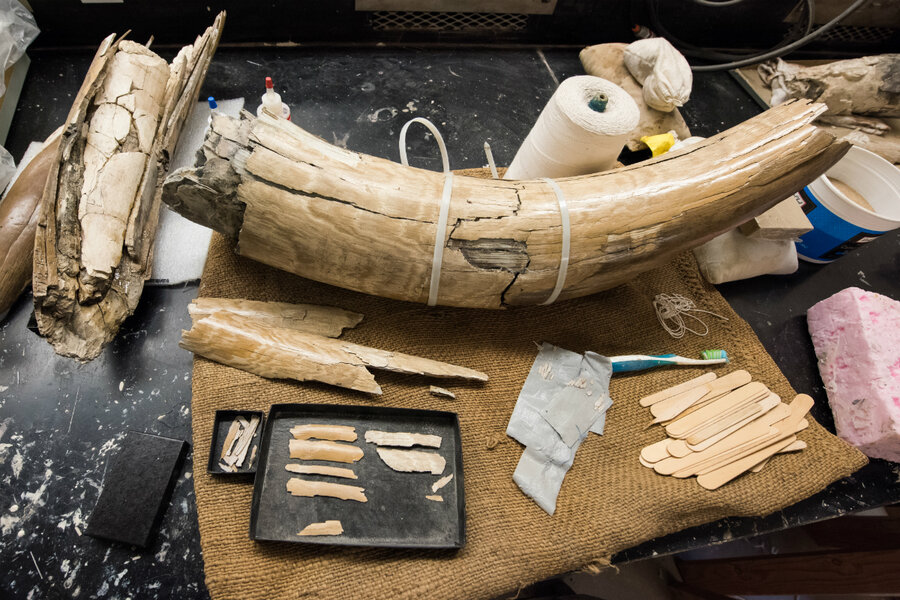Michigan mammoth bones: Lessons about early North American settlers
Loading...
This Saturday, the Bristle Mammoth exhibit will be opened to the public. But it won’t be complete – at least not for a while.
James Bristle was digging in his southern Michigan soybean field in October 2015, when he discovered the ancient pelvis of a woolly mammoth sticking out of the mud. Researchers from the University of Michigan later excavated about 20 percent of the animal’s skeleton, which appeared to have been processed by humans. That specimen will soon appear, much in the same way it was found, in the university's Museum of Natural History.
Preliminary radiocarbon dating suggests that the mammoth lived about 15,000 years ago – more than 1,000 years before the ancient Clovis hunters, who were thought to be the earliest modern people in Michigan. If that estimate is correct, it could revise our understanding of the peopling of the Americas. But even if it isn’t, the incomplete Bristle Mammoth exhibit could still give us a clearer perception of the scientific process.
It’s still too early to say for sure, but the Bristle mammoth does appear to show evidence of human interaction. The animal’s cranium had been broken while the bone was still fresh, and the location of those breaks suggest that something had manually removed soft tissue from within.
“This sort of damage is compatible with human processing of a carcass, but not with the way most non-human scavengers would deal with a carcass,” Daniel Fisher, director of the Museum of Paleontology at the University of Michigan, tells The Christian Science Monitor in an email.
The bones were found in distinct piles; researchers believe that humans may have cut the carcass into segments and moved it to another site. Large, fine-grained rocks were also found near the skeleton. Such stones have been associated with an ancient human practice that involved anchoring food underwater for later use.
Mammoths were a crucial food source for early modern humans. That’s why archaeologists take such an interest in these ancient pachyderms – they can be an excellent proxy for tracking human migration back tens of thousands of years.
Earlier this year, scientists discovered a 45,000-year-old mammoth skeleton in Siberia. Cut marks and bits of stone, as if broken from a weapon or tool, were found lodged in the bone. The finding suggests that anatomically modern humans were already in Siberia, if not further north, much earlier than previously thought.
In September, researchers unearthed an intact mammoth skull in the Channel Islands, just off the coast of California. The skull, which was too large to belong to a pygmy mammoth and too small for a Columbian mammoth, could offer insight into humanity’s migration into North America.
The Christian Science Monitor’s Rowena Lindsay reports:
The US Geological Survey analyzed a charcoal sample found near the skull and dated it to 13,000 years old, which places the mammoth and the Arlington man, thought to be the oldest human remains in North America, on the same island at the same time.
Researchers plan to return to Bristle farm next month for a second excavation and acknowledge that further studies are needed to confirm the preliminary results. That’s why Michigan’s Museum of Natural History will be housing an incomplete presentation of the Bristle mammoth, with extra space left over for future discoveries.
Scientific exhibits can be costly to build, and museums rarely have the staff to rework them multiple times. To account for this, curators must fill in the gaps, both literal and figurative. These exhibits may convey a sense of completion, despite the fact that research is incomplete or ongoing. But by leaving space for the exhibit to grow and change along with the science, Fisher says, museums can give visitors the “inside story” about how science operates.
“We felt that this would give people a better sense for how science operates than just handing them the slick, finished package,” Dr. Fisher says.








